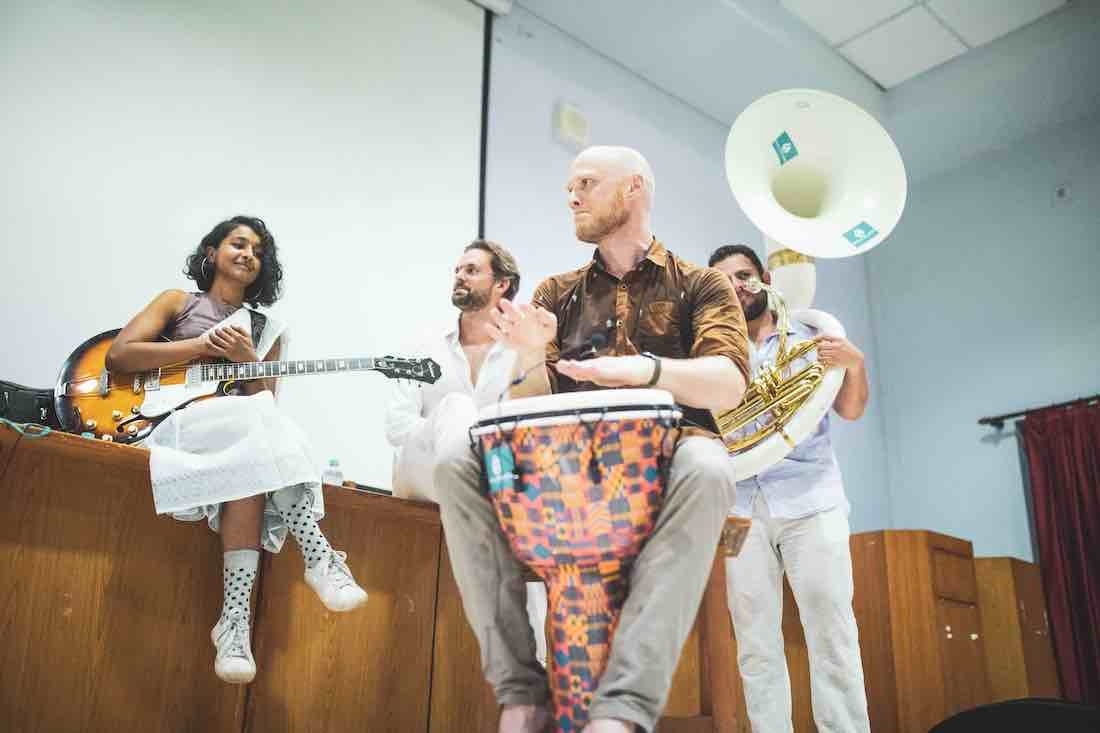
Photo by Julian Pircher

Photo by Julian Pircher
When we were first introduced to Ditty's voice, she was still studying architecture and piecing together her debut extended play. Cut to today, seven years later, Ditty is not just a singer/songwriter, but an architect and an urban ecologist. She is a conscious artist, on a mission to save the world with a guitar. Over the years, she has engaged in many initiatives such as her Streets For Us busking tour in Nepal, India and Sri Lanka with friend Lakshya Dhungana, that explored how art can be used to transform and reclaim the streets. Her newest offering is called Faraway Friends. The collective creates socially relevant art that funds real social work happening on the ground and makes space for conversation on these topics.
How was the collective, Faraway Friends formed?
Keno: The three of us — me, Ditty and David from Austria — first met in Varanasi. We were on a project trip through India, with the German NGO Viva con Agua, visiting the water conservation projects they have been funding. VCA's approach is to bring artists with them and use the universal language of music to connect on eye level with the communities. We were looking to meet Indian artists who were also interested in these social issues. We met Ditty at a concert in Varanasi. Instead of quickly making a song together as planned, we spent the whole night discussing ideas and became friends.
Ditty: We knew that we wanted to work together, make socially inspired art and create space for such conversations in the music world. We spent the next year working over endless Skype sessions and creating the record, Rain is Coming. Here we are today! More than twenty artists from all over the world, filmmakers, dancers, illustrators, and visual artists have joined us in this quest.
To create socially relevant art stands at the core of this collective. How do you find such stories?
Keno: We found the stories we wanted to tell through conversations, telling each other about our experiences and what we think is important in today's times. Part of the concept of Faraway Friends was to find ways of including voices of people from far away and letting them speak for themselves. On some tracks, David built music around actual interviews that were recorded during the trip. These parts of the record have a documentary dimension. In other cases, real persons inspired fictional stories, as in The Legend of Drops.
One story that we really think is inspiring and we’ve referenced on the record is the story of the Jal Sahelis. These are women water warriors. They take responsibility for the water supply of their rural communities in Bundelkhand, from building ponds to educating their communities.
Ditty, does Faraway Friends have a distinct music sensibility?
Ditty: The record has a very specific sound of its own because of the way it was created. It is very recognisable and doesn't fit into a box. David has sampled various sounds and turned them into beats and music. I took each song as it came and picked up influences from Keno and David along the way. Usually, when I pick up influences, in the end they turn into something quite original, something that I can call my own. I've always been very interested in using the voice — spoken and rap. This was such a beautiful experience, I did some spoken, and Keno and I wrote a rap song together.
Within the collective, who brings what to the table?
Keno: The groundwork for the record was done by David. He is a producer and recorded most of the samples on the trip. He loves field recordings. He turns crickets into instruments and drops into beats. Ditty and I wrote most of the lyrics and melodies for the music and directed the visual language and video work. Together, all three of us envisioned the various conceptual layers of the album, from stories to the presentation. We've been trying to reach out to like-minded artists around us, to help us with videos and visual artwork.
Ditty: Also, with Viva con Agua founding a music arm with Chimperator, we found a good place for the record. It's a social business and therefore it's great since we are not just trying to sell a record, but raise money for work that is happening on the ground.
Let’s talk about Rain is Coming.
Keno: People should listen to this record in its entirety. It's a multi-layered, conceptual artwork, that will take them on a trip through the world we've created together, using the sounds and experiences. Proceeds from the record go back to the projects that inspired it. We hope that many people will enjoy this music as much as we did making it.
What other plans do you have for the collective?
Ditty: This collective has already grown so much bigger than we expected and has taken a life of its own. We hope that we can continue to work in this way, bringing together activism and art. We are going to make more interdisciplinary work, comprising of films, music, art exhibitions and interventions!
Text Hansika Lohani Mehtani
Date 10-03-2021